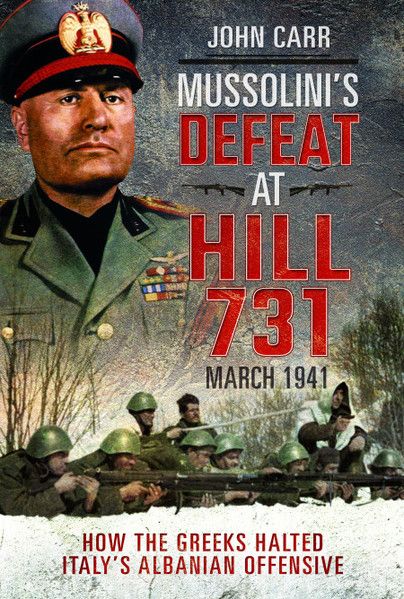| Title: | Mussolini's Defeat at Hill 731, March 1941 - How the Greeks Halted Italy's Albanian Offensive |
| Writer: | Carr, J. |
| Published: | Pen & Sword |
| Published in: | 2020 |
| Pages: | 219 |
| ISBN: | 9781526765031 |
| Description: | Although the title of the book refers to a specific part of the Italo-Greek war in early 1941, the book covers a lot more ground than that single battle. It starts with some background information on the Italian involvement in the war, and on Mussolini and his generals. And it tells about the Greek side as well. Who was at play, what were their reactions and intentions. Then it takes us to Mussoliniís disastrous plans for his Spring Offensive, intending to beat the Greeks who have surprisingly (to the Italians) driven the Italians back into Albania, away from the Greek border. This of course is a disaster for Mussoliniís over-large ego, especially so since it made him the laughingstock of the Germans. So, he wanted to show that his army was equal to the Germans, at any cost. The latter accounMussoliniís Defeat at Hill 731ts for a major loss in lives, on both the Italian and on the Greek side. The Spring Offensive operation attacks the Greek in the Albanian mountains, in what turns out to be a harsh winter, in a very unforgiving environment. The battle takes many lives and causes many wounded, but the weather greatly adds to those numbers with lots of cases of frostbite and other maladies. The title of the book refers to a well-defended hill that stood in the way of Mussoliniís prime attack plan. He wanted to send his armies through the Desnitsa valley to occupy Kelcyre and open the road to the Greek border. Looking at current-day photos of the hills (Hill 731 and Hill 717) they donít look too forbidding. These are not rocky, steep mountains like the ranges beyond and on either side. But because of the strong defensive positions, the Greek dug into them, they became an insurmountable barrier to the Italians. John Carr uses reports from the Greek and Italian military archives and soldiersí diaries to provide a feel of what it was like during the battles for the hills. Very gripping indeed. It really provides the reader with a better understanding of the harsh conditions the fighting men were facing, and about the courage and desperation displayed on both sides! While the battles for the entrance to the valley are raging, John Carr also tells us about the general strategic situation on that front and for the whole of Greece, with the Germans poised to attack from Bulgaria. Hitler and his generals clearly did not have much faith in Mussolini, nor in his army and air force, but were waiting to see how things developed, and hoping he would succeed, freeing the German forces from some of the tasks planned for them and enabling them to be used on the Eastern Front instead. One important fact that we can take away from the stories is the mistaken Ďassumptioní that the Italian soldier was a coward, always running away and giving up. The 21 attempts to storm the hill, despite fierce counterattacks by the Greek with hand grenades and bayonets, tells us otherwise. Of course, history is written by the winners, and Italy lost on all fronts throughout the war, ending up with a shady history of betrayal and cowardice. This book shows that the leadership of the armed forces were not very professional and the cause of much human hardship, but the lowly soldiers fought for all they were worth. The same is true for the Greeks. Their morale was better, as would any manís when fighting after being attacked, and their equipment was better too. But their persistence and courage ultimately saved the day and beat the Italians, and Mussolini and his generals. Unfortunately, it was all in vain, because ultimately Hitler sent his troops into Greece via Bulgaria, and like many other countries, Greece was no match for the superior German army and air force. The Greek troops from Albania were called back, leaving the terrain they defended with so much courage and blood to the Italians after all. Incredibly sad and demoralizing of course. The book has some maps in the first part, showing the positions of the units and the lay of the land. There is a group of photos in the center which are interesting. Last but most certainly not least is John Carrs report on what happened in recent years. ĎRecentí as in 1967, 1970ís and all the way up to 2019. As we know Albania turned into a sort of North-Korea after the war, a Stalinist dictatorship in the Balkans, and closed off to most western relations for 45 years, until communism collapsed in 1991 (or so we chose to believe). Both Italians and Greek had not forgotten their slain soldiers, with so many of them not accounted for and buried in some mass graves or in small individual graves throughout the area. Getting them back, recognized, and properly accounted for is what the last chapter of the book is about, and very much worth reading. Unfortunately, the Balkan being the Balkan, even up to today there is still hatred and mistrust between the countries and populations there, and so there still remain lots of missing soldiers and gaps in the actual history. This is a fascinating book, especially for those of us not specialized in the Balkan part of World War 2. John Carr really has delivered a great story here, professionally researched, and written in a very grasping way. |
| Rating: |     Very good Very good |
Information
- Article by:
- Francois Dumas
- Published on:
- 24-01-2021
- Feedback?
- Send it!




